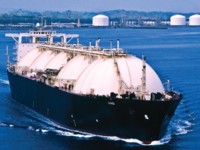B.C. releases Action plan for LNG sector
 British Columbia will need more than 75,000 permanent skilled workers once liquefied natural gas (LNG) projects are fully operational says a new report from the BC Natural Gas Workforce Strategy Committee.
British Columbia will need more than 75,000 permanent skilled workers once liquefied natural gas (LNG) projects are fully operational says a new report from the BC Natural Gas Workforce Strategy Committee.In addition, 60,000 workers will be needed during peak construction in 2016 and 2017.
“To make sure our province seizes the full opportunity of LNG, our first priority is building a strong and skilled B.C. workforce,” said B.C. Premier Christy Clark.
“The committee’s report is a first step towards charting the course for LNG, and we will continue to work with all partners to make sure British Columbians remain first in line for the best opportunities.”
It’s a message that Premier Clark will bring to her provincial counterparts at the Council of the Federation meeting opening tomorrow at Niagara-on-the-Lake, Ontario. The Premiers and Territorial Leaders will be discussing skills training, jobs and the economy.
“The largest employer in our province’s natural-gas industry, the oil- and gas-services sector, will create the most jobs in B.C. over the next decade, and it is crucial that we have a strategy in place to ensure we have skilled workers ready and trained for future growth,” said Minister of Jobs, Tourism and Skills Training and Minister Responsible for Labour Shirley Bond.
“It is critical to look at all sectors, including LNG, and take action to ensure that skills training is aligned with the jobs of today and tomorrow.” B.C. Shirley BondMinister of Jobs, Tourism and Skills Training and Minister Responsible for Labour
The BC Natural Gas Workforce Strategy Committee was formed in March 2012 to develop an understanding of the workforce needed to build and operate natural-gas-related projects, conduct an environmental scan of the potential labour supply available to the projects, and build a workforce strategy and action plan to address labour supply-and-demand concerns.
“LNG, the world’s cleanest-burning fossil fuel, gives B.C. an unprecedented opportunity to create a lasting legacy and employment for future generations to come,” said Minister of Natural Gas Development Rich Coleman.
“We have a vision of B.C. as a strong, prosperous and competitive economy and LNG will help us realize that vision for decades to come.”
Not all the natural gas to be produced in B.C. will be exported. BC Ferries, the province’s largest marine transportation utility has received permission to replace three vessels that are nearing the end of their service lives. Although design elements are yet to be finalized, BC Ferries intends to acquire LNG-fuelled vessels.
Labour Shortages could be a problem
The committee’s work to-date indicates that all stakeholders involved - industry, government and local communities - have a strong desire to ensure the local labour force and business sector are first to benefit from natural-gas investment in northern B.C.
However, northern B.C.’s labour force will simply not be able to meet the labour demand generated by the growth of the province’s natural gas industry.
The B.C. Natural Gas Workforce Strategy and Action Plan identifies the need to take action to increase the employment of local talent, as well as attract and retain talent from other regions, says a B.C. government press release.
The report’s conclusions with respect to the need for new labour force skills are consistent with the findings of research conducted over the period 2010 - 2012 by GLOBE Advisors on B.C.’s green economy.
A 2010 GLOBE Advisors report noted that BC’s green economy was responsible for nearly 166,000 full-time equivalent (FTE) jobs, equivalent to 7.2 percent of total provincial employment, and that the green economy sectors could grow to between $20.1 billion and $27.4 billion by 2020. Labour shortages and new skill requirements were seen as the greatest threat to this potential growth.
Next steps on the road to LNG:
Addressing barriers to employment.
Developing information, standards and tools to serve as foundations to further action.
Delivering workers to current in-demand jobs in upstream natural-gas operations.
“Over the past year, the committee met extensively with industry partners and First Nations to discuss the tremendous scope of LNG opportunities in B.C. and identify the need for skilled workers during the development and implementation phases of LNG projects,” said Geoff Stevens, chair of the BC Natural Gas
Workforce Strategy Committee.
“The report outlines our key findings and provides government and its many partners with an overview that will help inform future decision making about LNG in our province.”
“Skilled workers are the key to building and operating LNG facilities like the one that we are proposing in Port Edward,” said Greg Kist, president of Pacific NorthWest LNG. “Today’s announcement is a step toward meeting our skilled-labour needs and an acknowledgement that this emerging LNG industry is an opportunity for all of Canada to embrace.”
You can return to the main Market News page, or press the Back button on your browser.

